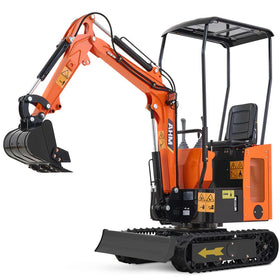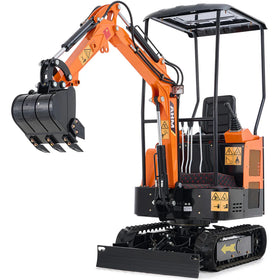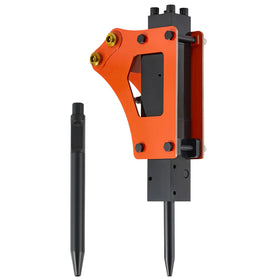Mini excavators are a must-have for construction projects where space is limited but digging and lifting capacity is still needed. With mini excavator weights ranging from under 1 ton to over 10 tons, it can be challenging to pick the right size machine. This guide will walk through key factors in choosing the optimal mini excavator for your projects.
(Reading Time: 3-5 Minutes)

Common Mini Excavator Weight Classes
Mini excavators typically fall into these operating weight classes:
Less Than 1-Ton Mini Excavator (800-1,999 lbs)
Very few excavators weigh in at less than a ton. But they can make great tools for smaller projects. Their compact design enables easy maneuvering and operation even in confined spaces. Their limited dimensions make them ideal for homeowners tackling DIY landscaping jobs.
These mini excavators are especially useful for digging trenches for utilities or tasks like laying pipes for sprinkler systems. Their light operating weight means they lack the capacity to rip through rock and highly compacted ground compared to heavier models. If your small space project requires more power, consider sizing up.
| Conclusion: Under 1-ton mini excavators suit smaller jobs like yard work on property with limited space. But highly compacted surfaces may need a larger excavator. |
1- to 2-Ton Mini Excavator (2,000-4,000 lbs)
1 to 2 ton mini excavators remain relatively compact yet have additional power and digging abilities. Most brands offer mini excavators in this size range, with it being the smallest for many.
These can dig trenches 7 to 8 feet deep, ideal for utility and drainage system installation. They can also operate grading buckets used by contractors to flatten surfaces.
Excavators of this size efficiently transport and dump challenging materials like wood, soil, and stone around sites. They sufficiently handle small demolition projects like asphalt removal.
| Conclusion: 1- to 2-ton mini excavators are practical for trenching up to 10 feet deep, grading, and small structure demolition. |
3- to 5-Ton Mini Excavator (6,000-10,000 lbs)
While still compact, 3-5 ton mini excavators provide more power and functionality. Typical applications include trenching, foundation digging, and general site prep.
These excavators can dig 8 to 12 foot trenches, great for pipe and cable contractors. Their extra power suits foundation digging for homes and smaller buildings.
They also handle site prep tasks like clearing land with rubble removal and snow plowing.
| Conclusion: 3-5 ton excavators are used in construction for trenching up to 12 feet deep, foundation digging, and clearing sites for further work. |
6- to 10-Ton Mini Excavator (12,000-20,000 lbs)
This represents the largest size class considered compact. For maximal power and digging capacity in confined spaces, choose a larger machine in this 6-10 ton range.
These compact excavators can dig up to 15 feet deep. Check specifications to ensure the model fits your needs. Common jobs are trenching and backfilling. These machines also dig foundations for houses and smaller commercial buildings.
Other applications include demolition, heavy material removal, and removing stumps and rocks from land.
| Conclusion: 6-10 ton excavators dig up to 15 feet for trenching, backfilling, foundation work, clearing land, and construction material transport. |
Mini Excavator Key Specifications and Considerations
When it comes to selecting a mini excavator for your project, it's crucial to look beyond just its weight classification. While operating weight is a primary consideration, several other specifications play a vital role in determining the machine's suitability for specific tasks. Let's delve into the essential specs that should guide your decision-making process.
Operating Weight
The operating weight of a mini excavator is a pivotal factor, reflecting its overall stability and capacity. Comprising the machine's weight, operator, and fuel, it acts as the counterbalance to the load in the bucket. For projects involving substantial lifting and excavation through dense materials, opting for a mini excavator with a higher operating weight is imperative.
Related post: How Much Does a Compact Excavator Weigh?
Digging Depth
The digging capacity, or depth, signifies the excavator's ability to penetrate surfaces. As a rule of thumb, larger mini excavators tend to offer greater digging depth. However, the specifications can vary across makes and models, necessitating a thorough check to ensure alignment with your project requirements.
Overall Dimensions
While the compact design of mini excavators is advantageous for working in confined spaces, variations in dimensions exist. Verifying the excavator's height, width, and length against the working area's measurements is crucial to ensure optimal fit and functionality.
Engine Power
Measuring engine power in horsepower (HP) or kilowatts (kW), this specification indicates the machine's capability to generate power. Higher engine power translates to more energy for tasks such as digging large loads and breaking through compact surfaces.

Bucket Breakout Force
Bucket breakout force quantifies the maximum force the excavator bucket can exert, typically measured in pound-force. Understanding this force is vital as it directly influences the machine's digging and lifting capacity. A higher breakout force equips the excavator to handle substantial loads more efficiently.
Arm Reach
The arm's reach denotes how far it can extend, a critical specification even in confined spaces. Ensuring that the arm's reach aligns with your project's digging and reaching needs is essential, striking a balance between adequacy and practicality.
Swing Space
In tight working spaces, the swing space, referring to the machine's ability to rotate without obstruction, is paramount. Options like low and zero-swing excavators cater to projects with space constraints, allowing efficient operation without compromising maneuverability.
Dumping Height
The dumping height is the maximum height at which the excavator's arm can dump or scoop materials from its bucket. This specification determines the compatibility with dumpsters, trucks, or other containers for loading or unloading.
Understanding Mini Excavator Limitations: What to Keep in Mind
While mini excavators stand out as versatile and efficient machines, it's crucial to be aware of their limitations for informed decision-making. Here's a breakdown of some of the most common constraints associated with mini excavators:
- Digging Depth and Reach: Mini excavators are typically designed for tasks involving shallower depths and shorter reaches compared to their larger counterparts. This limitation can impact their suitability for specific applications, such as digging deep trenches or reaching over obstacles. It's essential to evaluate the project's depth requirements to ensure the mini excavator aligns with the task at hand.
- Lifting Capacity: One notable limitation of mini excavators is their lower lifting capacity in comparison to larger machines. This aspect may make them less suitable for tasks that involve demolishing and lifting extremely heavy loads. Assessing the weight requirements of your project is crucial to determine if a mini excavator can handle the lifting demands effectively.
- Stability: Mini excavators, being lighter than their larger counterparts, may face challenges in maintaining stability on uneven terrain. If a job site involves navigating extremely rocky or sloping landscapes, opting for a larger machine might be necessary to ensure enhanced stability during operation. Careful consideration of the terrain is vital to prevent potential stability issues.
- Fuel Capacity: Another limitation stems from the smaller fuel tanks on mini excavators in comparison to larger models. The reduced fuel capacity means that the running time is shorter, necessitating more frequent refueling. This aspect should be taken into account, especially for projects with extended working hours, to avoid disruptions due to frequent refueling requirements.
When deciding between a mini excavator and its larger counterpart, it's imperative to meticulously evaluate the specific requirements of the job. Matching the machine to the project's needs ensures optimal performance and efficiency, minimizing the impact of these limitations. Always prioritize a thorough assessment to guarantee that the chosen excavator is well-suited for the demands of the task at hand.

How Much Does It Cost to Rent a Mini Excavator?
Rental rates for mini excavators start at:
|
Weight |
2,000-3,999 lbs |
4,000-5,999 lbs |
6,000-7,999 lbs |
8,000-9,999 lbs |
10,000-11,999 lbs |
12,000-13,999 lbs |
14,000-15,999 lbs |
16,000-17,999 lbs |
|
Daily rate |
$175 |
$186 |
$209 |
$271 |
$307 |
$301 |
$357 |
$311 |
|
Monthly rate |
$1,558 |
$1,673 |
$1,754 |
$2,271 |
$2,501 |
$2,655 |
$2,852 |
$3,622 |
Rates vary by rental term, location, and additional features.To learn more about the advantages of buying an excavator instead of renting one, check out the article: Compact Excavators To Buy or Rent?
By carefully considering digging requirements, site constraints, and project loads, you can select the most compact and cost-effective mini excavator. Sizing appropriately maximizes maneuverability and productivity.
Related post: Comparing Mini Excavator Rental vs. Mini Excavator Purchase
How Much Can a Mini Excavator Dig Per Day?
The volume a mini excavator can dig in a single day depends on several variables, including the machine's size, site soil, and target depth. As a general guideline, mini excavators typically dig 8 to 12 cubic yards of soil per hour. Based on an 8-hour workday, that translates to 64 to 96 cubic yards per day.
However, note that this is a rough projection. The actual output varies based on the specific on-site conditions and operator's technique. For a more customized estimate, factor in the excavator bucket capacity, your cycle times, and projected work hours. As a formula:
| Cycle Time x Bucket Capacity x Work Hours = Daily Dig Volume |








